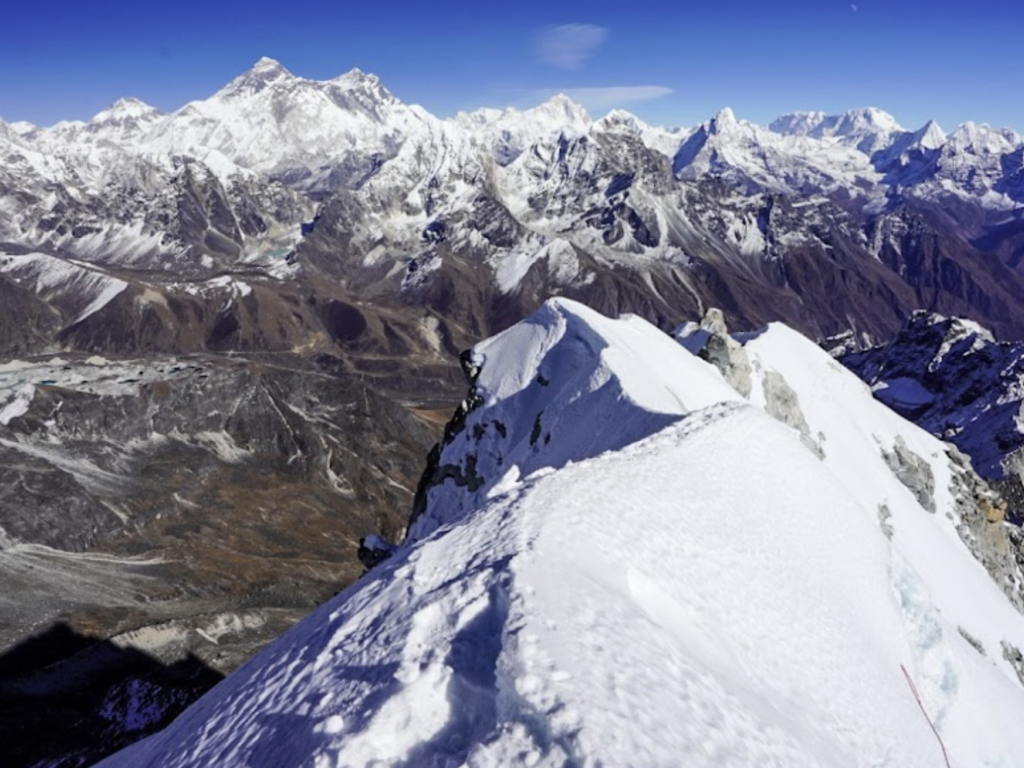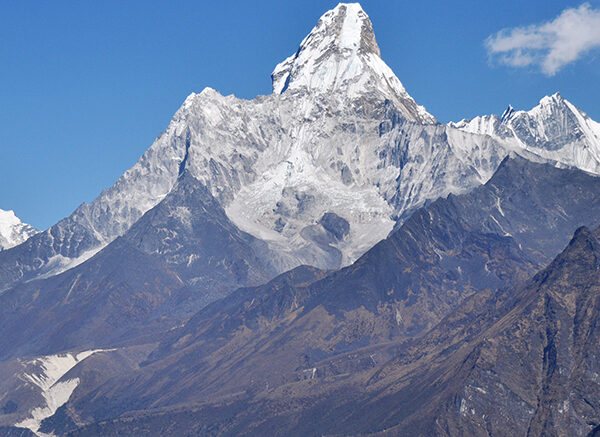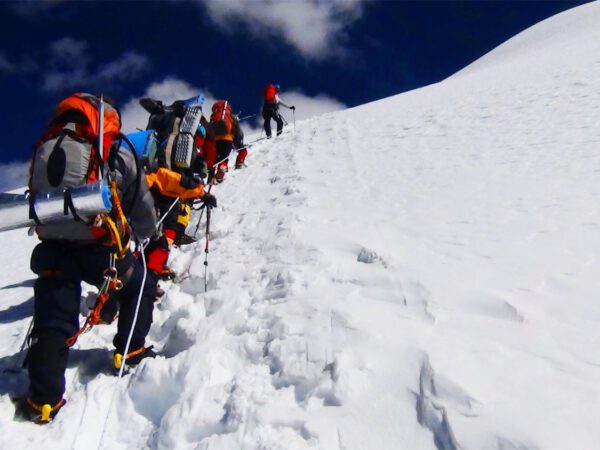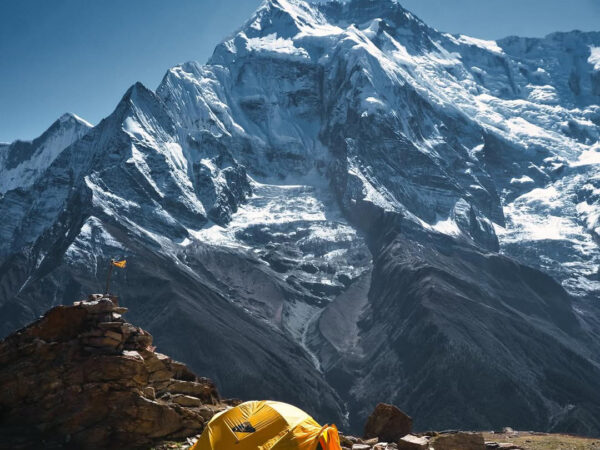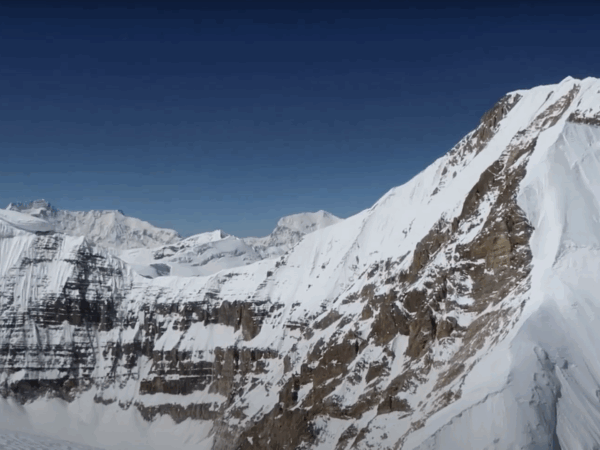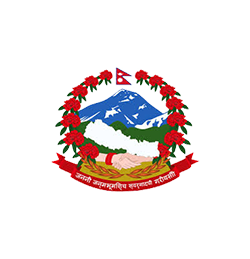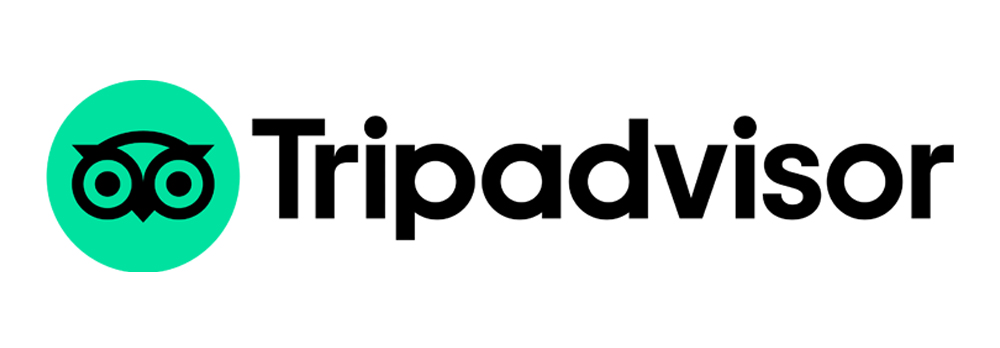Highlights
- Remote and Less Crowded Climbing Peak – Unlike other trekking peaks in the Everest region, Kyajo Ri (6,186m) offers a true mountaineering experience in a secluded setting.
- Summit a Technical 6,000m Peak – A challenging climb that involves glacier travel, steep snow slopes, and rock climbing, making it ideal for experienced climbers.
- Breathtaking Mountain Views – Panoramic vistas of Everest (8,848m), Lhotse (8,516m), Makalu (8,485m), Cho Oyu (8,188m), Ama Dablam, and other Himalayan giants.
- Scenic Trek through the Everest Region – Trek through lush forests, picturesque Sherpa villages, and high alpine landscapes en route to the base camp.
- Experience Sherpa Culture and Traditions – Visit Namche Bazaar, the vibrant heart of the Khumbu region, and explore monasteries and prayer flags along the way.
- Technical Climbing Adventure – Requires the use of climbing gear such as ropes, ice axes, and crampons, making it a perfect test of mountaineering skills.
- Well-Planned Acclimatization Schedule – Ensures a safe ascent with rest days and gradual elevation gain to reduce the risk of altitude sickness.
- Camping in a Remote Alpine Setting – Enjoy the thrill of staying in high-altitude camps amid the pristine wilderness of the Khumbu Himal.
- Thrilling Lukla Flight – Experience the adventure of flying into one of the world’s most exciting airports, the gateway to Everest.
Overview
Experience the Thrill of Climbing a Remote 6000m Peak in Nepal
Kyajo Ri Peak Climbing offers an extraordinary opportunity to conquer a rarely climbed 6,186m (20,296ft) peak in Nepal. Nestled between the Thame and Gokyo valleys, Kyajo Ri stands as one of the most secluded trekking peaks, promising a pure expedition-style climb. With expert guidance, a well-structured itinerary, and a strong emphasis on safety, this adventure is perfect for experienced climbers looking for a unique high-altitude challenge.
History
The Nepalese Ministry of Tourism officially opened the peak for climbing in 2002, and that same year, a Franco-British team made the first recorded ascent. Their route began in Machhermo, crossing the Kyajo Glacier before ascending via the Southwest Ridge. In 2003, a French team repeated this route as an acclimatization climb before successfully tackling the challenging North Face of Machhermo Peak, an ascent they named Bonfire of the Vanities. That same year, a Dutch team also climbed the Southwest Ridge after an unsuccessful attempt on the East Face.
In 2005, an American team pioneered a more demanding line—the Southeast Ridge—establishing only the second recorded route on the mountain. Subsequent attempts included an Australian expedition in 2005, an American team in spring 2006, and possibly a Korean team, along with others whose efforts remain undocumented.
Notably, evidence suggests that climbers may have reached the peak even before its official opening. At our high camp—distinct from those used by the expeditions mentioned above—we discovered remnants of past human presence, including old cans and rock tent enclosures, indicating that someone had been there before us.
Why Choose Kyajo Ri Peak?
- Remote and Less Crowded: Unlike other popular trekking peaks, Kyajo Ri remains largely unexplored, offering a serene and pristine climbing experience.
- Expedition-Style Climb: A true test of mountaineering skills with a mix of rock, snow, and ice climbing.
- Acclimatization Trek to Gokyo & Renjo La Pass: Enhances summit success by ensuring proper altitude adaptation.
- Expert Guides & Safety Assurance: Guided by seasoned mountaineers with a 1:3 guide-to-client ratio on summit day.
Kyajo Ri Peak Climbing Itinerary Highlights
To maximize acclimatization and summit success, our itinerary includes:
- Gokyo Valley Trek: Explore breathtaking landscapes and pristine glacial lakes.
- Gokyo Ri Ascent (5,357m/17,575ft): A rewarding viewpoint with stunning Everest region panoramas.
- Renjo La Pass Crossing (5,340m/17,520ft): A thrilling high-altitude pass before reaching Kyajo Ri Base Camp.
- Multi-Camp Climbing Strategy: Two high camps ensure a well-paced ascent with minimal risk.
Kyajo Ri Climbing Route
Standard Route: South Face via Southwest Ridge
- Base Camp to Camp 1 (5,350m): A non-technical approach over rocky terrain.
- Camp 1 to Camp 2 (5,700m): A short but technical section involving scree and boulders.
- Camp 2 to Summit (6,186m): A demanding climb with 12 pitches of snow and ice, including two steep 60-degree sections just before the summit.
Alternative Routes:
- Southeast Ridge: A more technical variation.
- Northeast Face: Requires advanced technical skills and is less frequently attempted.
Best Time for Kyajo Ri Peak Climbing
Spring (March-May): Stable weather, clear skies, and ideal climbing conditions.
Autumn (September-November): Dry trails and excellent visibility for a rewarding summit experience.
Is Kyajo Ri Peak Climbing for You?
- Climbing Grade: Strenuous
- Physical Rating: 7-8 (Very demanding)
- Total Duration: 25 Days
- Trekking Days: 17 Days
- Climbing Days: 4 Days
- Maximum Elevation: 6,186m/20,296ft
Required Experience:
- Prior trekking/climbing experience above 5,000m is recommended.
- Strong physical fitness and endurance.
- Familiarity with mountaineering equipment (crampons, harness, ice axe, ascender).
- A pre-climb training session at Base Camp is included.
Why Climb Kyajo Ri with Us?
- At Everest Hikes, we prioritize safety, success, and unparalleled service. With over 30 years of experience in high-altitude expeditions, we provide:
- Small group sizes for better coordination and support.
- Highly experienced and professional climbing guides.
- A well-planned itinerary for proper acclimatization.
- High-quality logistics, including meals, equipment, and safety gear.
For those seeking less technical alternatives to Kyajo Ri, Island Peak (6,189m), Mera Peak (6,476m), and Lobuche East Peak (6,119m) are excellent options. These peaks offer a challenging yet achievable climbing experience with fewer technical sections, making them suitable for trekkers looking to step into Himalayan mountaineering. Island Peak is ideal for first-time climbers, Mera Peak provides a high-altitude trekking experience with stunning views, and Lobuche East offers a slightly more demanding ascent with rewarding panoramas of Everest and its neighboring peaks.
Book Your Kyajo Ri Peak Adventure Today!
Are you ready to challenge yourself on one of Nepal’s least explored 6000m peaks? Secure your spot for an unforgettable Himalayan expedition with Everest Hikes. Contact us today for detailed itineraries, pricing, and expert guidance!
Kyajo Ri Peak Climbing – 17 Days | A True Himalayan Adventure - Itinerary
Arrival in Kathmandu (1,350m) – Transfer to Hotel
Upon arrival at Tribhuvan International Airport, our representative will welcome you and transfer you to your hotel. In the evening, enjoy a welcome dinner and a briefing about the expedition.
Trip Preparation & Trek Briefing
Today, we will conduct a final gear check and trek briefing. You can explore Kathmandu’s UNESCO sites or do last-minute shopping for climbing essentials.
Fly to Lukla (2,800m) & Trek to Phakding (2,652m) [3-4 hrs]
A scenic 35-minute flight takes us to Lukla, the gateway to Everest. From Lukla, we trek through Sherpa villages and lush forests to Phakding.
Trek from Phakding to Namche Bazaar (3,438m) [5-6 hrs]
We follow the Dudh Koshi River, crossing several suspension bridges, including the famous Hillary Bridge. A steep ascent leads us to Namche Bazaar, the Sherpa capital.
Acclimatization Day in Namche Bazaar
We hike to Everest View Hotel (3,880m) or Khumjung village to aid acclimatization. Enjoy stunning views of Everest, Lhotse, and Ama Dablam before returning to Namche.
Trek from Namche Bazaar to Mende (3,736m) [5-6 hrs]
Trek from Mende to Kyajo Ri Base Camp (4,550m) [5-6 hrs]
We trek through rugged terrain and cross moraines before setting up camp at Kyajo Ri Base Camp, surrounded by towering peaks.
Rest & Acclimatization at Base Camp
To adjust to the altitude, we take a short acclimatization hike towards Camp I and return to Base Camp for rest.
Trek from Base Camp to Camp I (5,200m) [4-5 hrs]
The climb to Camp I involves navigating rocky and icy terrain. The views become more spectacular as we ascend higher.
Acclimatization & Rest at Camp I
We take another acclimatization day and practice basic climbing techniques while preparing for the higher camps.
Trek from Camp I to Camp II (5,700m) [4-5 hrs]
The ascent to Camp II involves climbing steep snow slopes and crossing icy ridges, requiring the use of crampons and ropes.
Summit Day – Kyajo Ri Peak (6,186m) & Return to Camp II [7-8 hrs]
We begin the climb early in the morning, navigating steep snow and ice slopes. After reaching the summit, we enjoy breathtaking 360-degree views of Everest, Lhotse, Cho Oyu, and Makalu before descending to Camp II.
Trek back to Kyajo Ri Base Camp [4-5 hrs]
We carefully descend back to Base Camp, celebrating our successful summit.
Trek from Base Camp to Namche Bazaar [5-6 hrs]
We retrace our steps to Namche Bazaar, enjoying the comforts of warm meals and tea houses.
Trek from Namche to Lukla [6-7 hrs]
The final trek descends through forests and villages before arriving in Lukla, where we celebrate our expedition.
Fly Back to Kathmandu
A short flight brings us back to Kathmandu. You can relax or explore the city before an optional farewell dinner.
Final Departure
After breakfast, we transfer you to the airport for your departure.
Inclusions
What's included
- Airport and hotel transfers (pickups and drops)
- Accommodation in a 3-star hotel in Kathmandu, teahouses, and tents during trekking and climbing
- Private ground transportation as per the itinerary
- Experienced English-speaking trekking and climbing staff, including a lead trekking guide, climbing guide, assistant guides, and porters (with their salary, insurance, equipment, flights, food, and lodging covered)
- Round-trip domestic flights (Kathmandu – Lukla – Kathmandu)
- Breakfast in Kathmandu and all meals (Breakfast, Lunch & Dinner) during the trek
- Porter services for trekking
- All necessary permits and paperwork for trekking and climbing
- High-quality camping gear, including tents and kitchen utensils
- Everest Hikes duffel bag, t-shirt, and trekking map
- Group mountaineering equipment for climbing
- Comprehensive medical kit
- Travel and rescue arrangements
- Company services and all applicable government taxes/royalties
What's not included
- Nepalese visa fee (requires exact USD cash and two passport-sized photographs)
- International airfare to and from Kathmandu
- Excess baggage charges (for luggage exceeding 15 kg, the cargo charge is approximately $1.5 per kg)
- Extra accommodation in Kathmandu due to early arrival, late departure, or early return from the mountain for any reason outside the scheduled itinerary
- Altitude chamber (PAC) or supplemental oxygen
- Lunch and dinner in Kathmandu, as well as meals in case of early return from the mountain outside the scheduled itinerary
- Travel and rescue insurance
- Personal expenses, including phone calls, laundry, bar bills, battery recharge, extra porters, bottled or boiled water, showers, and heating
- Personal climbing equipment
- Personal climbing guide (if requested)
- Optional trips and sightseeing beyond the itinerary
- Tips for guides and porters
- Any services not mentioned in the "inclusion" section

